They are the two words that anyone who ever huffed and puffed around a soccer field as a kid longed to hear while waiting for the whistle to blow: Water break!
For the first time in history, the best players in the world heard the same thing on Sunday, although no one's mom remembered to bring the orange slices. In the 40th minute of the thrilling 2-2 tie between the United States and Portugal, the referees stopped the action and ordered the players to go on a three-minute water break, resulting in a sight never seen at a World Cup game.
You would think they were playing the game in the middle of the Amazon rain forest or something. Actually, they were: The game was played in the Brazilian city of Manaus in the middle of the Amazon, and the temperature was 84 degrees with 70 percent humidity.
Still, there have been plenty of sweltering games at past World Cups, so why the water break at this one? Because it's court-mandated, and FIFA, the governing body of the World Cup, risks a $90,000 fine for every game in which the rule isn't enforced, according to The Associated Press.
The World Cup, explained: How can the US move ahead now?
A Brazilian labor court ordered FIFA (which stands for Federation Internationale de Football Association) to introduce water breaks at games during which temperatures reach 89.6 degrees according to the Wet Bulb Globe Temperature index, which takes into account factors such as time of day, cloud cover, wind, humidity and location, the AP reported. The combination of the temperature and the humidity put the heat index over that threshold on Sunday, resulting in the officials declaring a mandatory water break. (Orange slices were optional.)
Q. What is that "magic spray" that team trainers have used on injured players that has helped get them back in the game?
A. No, not the spray that looks like shaving cream and is used to keep the defense honest, but the spray that seemingly heals injured players in minutes to get them back on the field. It could be a number of things, from "skin refrigerants" that contain a chemical that numbs the spot of the injury for a few minutes to a substance like tincture of benzoin, which helps a bandage stick in a sweaty spot.
Also, in some cases, the reason a player might get the spray and seem suddenly healed is that he was totally faking the injury the whole time and the spray is for appearance's sake. This is soccer after all, where players falling to the ground and clutching a body part in agony and then returning to the game looking completely fine two minutes later drives fans nuts.
Q. How many miles on average does a player run during a game?
A. Clearly it depends on the position he plays (obviously goalies are not running very far), but according to data produced by SportVU, a sports technology company that tracks the movement of players throughout the game, the average player runs about seven miles during the course of a game.

While just thinking of that might make you tired, there is another group who has to cover even more ground than most of the players: the referees. Their job is to always be no more than 20 yards away from the ball so they can make accurate calls. That means running. And running. And running. Players usually are responsible for only their specific areas of the field, whereas referees have to cover the whole thing.
The lone American referee in the World Cup, New Jersey's Mark Geiger, 39, was a cross country runner in high school who keeps in shape with a punishing workout of sprints, according to Runner's World.
Q. The loud chants, the singing — how many people are at these games?
A. There are 12 different stadiums that will host games in Brazil during the World Cup, and their seating capacity ranges from 42,968 (at Estadio Pantanal in Cuiaba) to 76,804 (at Estadio do Maracana in Rio de Janeiro). Most of the venues are in the 45,000-50,000 range in capacity.
So far, only one game, Argentina vs. Bosnia, has had 100 percent attendance, according to Reuters. Three other games have had 99 percent attendance, and overall, the stadiums have been an average of 92.8 percent full in the early round of the tournament.
However, just because fans aren't inside doesn't mean they're not watching in the general vicinity. FIFA has Fan Fest areas set up outside the 12 stadium areas with big screens where fans can gather to watch games. FIFA claims that more than a million fans have already watched the games outside at Fan Fest venues.
Follow TODAY.com writer Scott Stump on Twitter and Google+.
